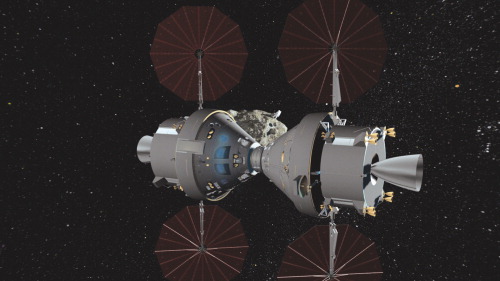NASA's New Spaceships Could Tag-Team Asteroid

A manned asteroid mission using two Orion spacecraft, dockednose-to-nose to form a 50-ton deep space vehicle, is being studied by LockheedMartin Space Systems as an alternative to resumption of U.S. lunar landingmissions.
The Orion asteroid missionconcept is being unveiled just as the Presidentialcommittee reviewing U.S. human space flight is citing asteroid missionsafter 2020 as a less costly alternative to NASA's proposed lunar landinginfrastructure. Results of the review will be briefed to President Obama byNorman Augustine, committee chairman, by the end of August.
The docked Orion configuration as shown in a Lockheed Martingraphic (above) would have a total of four large solar arrays and two servicemodules as well as two command modules for extra space on the several weekflight. Single 25-ton Orionspacecraft would first be used to replace the space shuttle for servicingthe International Space Station. But use of them for asteroid missions andother deep space sites would maximize utilization of the Orion system if lunarlandings are deleted as a near term goal.
If one looks closely at the graphic, a space suitedastronaut deployed from the Orion, is standing atopthe asteroid. The graphic is from a Lockheed Martin promotional movie thatshows concepts under study by the Orion prime contractor.
Under the Bush Administration strategy, NASA had planned aresumption of lunar landing missions by about 2020 using the Orion as a lunarorbiting command ship while its crew descended to the moon in Altair landersfor lengthy stays on the surface.
The official NASA line has been solidly "all moon"for the last several years, while more realistic assessments over the sameperiod have shown that is not feasible. NASA more recently, however, had becomemore open about an asteroid mission capability for Orion after space scientistsand planners meeting before formation of the committee began to criticize the lunargoal as too fragile.
Development and cost problems with the Ares 1 and Ares 5launch vehicle programs have also become increasingly apparent since about2007.
Get the Space.com Newsletter
Breaking space news, the latest updates on rocket launches, skywatching events and more!
Augustine and other committee members such as formerastronaut Sally Ride have already reportedpublicly that NASA's current plan to retire the shuttle, finish the spacestation and return to the moon by the early 2020s is not even remotely feasibleunder NASA's current funding profile.
Orion missions to asteroids would be useful to characterizeand sample them. This would be important as early preparation to use some yet undeterminedsystem if the need ever arose to divert an asteroid to save Earth from adevastating impact. Some asteroids are solid bodies, while others are rubblepiles of loose rock, making samples and close up characterization useful fordiversion studies that would differ depending upon the type of asteroidthreatening Earth.
In fact a Lockheed Martin video titled "Orion ForCrewed Science Missions" shows the twin Orion configuration closelyorbiting an asteroid while space suited astronauts explore its surface. Withthe minuscule gravity of an asteroid, astronauts flying manned maneuveringunits could travel between the Orion combo and the object without everrequiring a much heavier, and expensive, asteroid landing vehicle.
The video, little noticed at the time, was shown in earlyAugust at a propulsion conference in Denver sponsored by the American Instituteof Aeronautics and Astronautics. The AIAA "Joint PropulsionConference" so called because it brings together multiple international agenciesoften makes news as it also did in 2008 when Chinese researchers openlydiscussed their scramjet technology program.
At this year's event, the Lockheed Martin video was part ofa presentation delivered by former astronaut Brian Duffy, now Lockheed Martinvice president and program manager for the Altair lunar module part of theOrion lunar landing infrastructure.
Duffy's presentation also cited satellite servicing thatcould be performed by astronauts from an Orion configuration, equipped with ashuttle-type manipulator arm deployed from its service module.
The presentation also discussed use of single Orionspacecraft to service geosynchronous orbit military and civilian satellites andthe potential for them to travel to Lagrangian points to service telescopeslike the giant new Webb space telescope set for launch in about four years.Lagrangian points balance out gravity from the sun, Earth and moon allowingspacecraft to remain parked at those locations. They are about 1 million mi.from Earth, about the same distance as some asteroids passing near Earth. Thismeans Orions configured for missions to telescopes, like Webb, at Lagrangianpoints would have a life support capability also generally suitable forasteroid missions.
The twin Orion design includes large service modules on eachspacecraft to allow extra space for astronauts to live in. More importantlymore capability to carry life support systems for several week missions couldbe carried in the two service modules.
- Video - Bootprints on Asteroids
- Video - NASA's Constellation Journey Begins: Part 1, Part 2
- Image Gallery - Mars Base of the Future
Copyright 2009 SpaceflightNow.com,all rights reserved.
Join our Space Forums to keep talking space on the latest missions, night sky and more! And if you have a news tip, correction or comment, let us know at: community@space.com.









